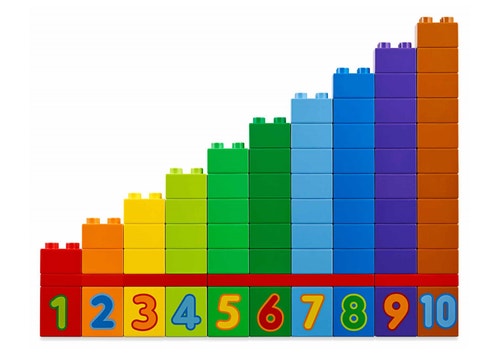Matching numbers
This is a getting started activity where the children will begin matching numbers to quantities and practice counting and
recognizing the number of objects

Connect
Ask the children to sit in a circle.
Build a tower and model how to count the bricks one by one to find the total number of bricks used.
Consider asking questions like:
-How many bricks were used to build the tower?
-How did I find the total number of bricks?Tell the children that they are going to play counting games.
Use removable tape, a play mat, or something similar to mark a circle large enough for multiple children to stand inside.
Tell the children that when you hold up a brick with a number on it, the same number of people must jump into the center of the circle.
Model the activity by holding up the number one brick and jumping into the center of the circle yourself.
Ask the children, “how many people are inside the circle?”
Hold up the brick representing the number of children participating in the activity so that they all must jump into the circle.
Count the children one by one to “check” the total.
Repeat with as many numbers as desired.
Construct
Tell the children that they are going to practice using the special number bricks.
Model this activity by showing the number one brick and finding the corresponding number of bricks in the same color (i.e., one red brick).
Ask the children to take turns finding the next number brick in the sequence of 1-10. Then encourage them to find the corresponding number of bricks in the same color (i.e., two orange bricks, three yellow bricks, etc.).
Ask them to place the flat red 2X4 bricks on top of the number bricks and then stack the corresponding color bricks on top as shown in the inspiration photo.
Encourage the children to check their work by counting the bricks out loud as they build.
Contemplate
Facilitate a discussion about numbers.
Consider asking questions like:
- Which number did you add to the model/sequence?
- How many colored bricks did you have to find to match your number?
- What do we use numbers for?
- Why are numbers important?
Continue
Use the stacks of bricks to play a game.
Put all of the number bricks in a pile, then ask the children to take turns matching the number bricks to the stacks of bricks.
Give each child a copy of the printable graph and ask them to color in the appropriate number of bricks for each number in the graph. For younger children,
model the activity and complete it as a group.

Did you notice?
Observing the following skills can help you monitor whether the children are
developing the necessary competencies in math.
- Counting using number names, and beginning to recognize the number of objects in a set
- Recording simple data in a chart or graph
Teacher Support
Children will:
- Explore the components of the Math Train set
- Begin matching numbers to quantities
- Practice counting and recognizing the number of objects in a set
For up to 6 children
Math Train set (45008)
Removable tape
A play mat (or something similar to mark a circle large enough for multiple children to stand inside)
Inspiration photo
Printable graph (one per child)
crayons or colored pencils
The Mathematics guidelines from the National Association for the Education of Young Children (NAEYC) and HeadStart have been used to develop the Math Train lessons. Please refer to the learning grid for an overview of the learning values referenced throughout this Teacher Guide.
The learning goals listed at the end of each lesson can be used to determine whether or not each child is developing the relevant early math skills. These bullet points target specific skills or pieces of information that are practiced or presented during each lesson.




